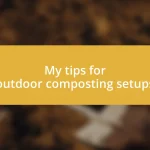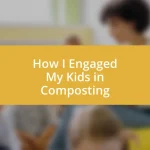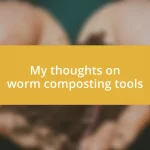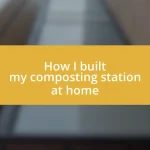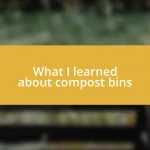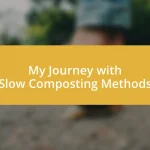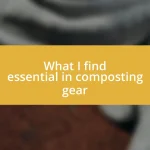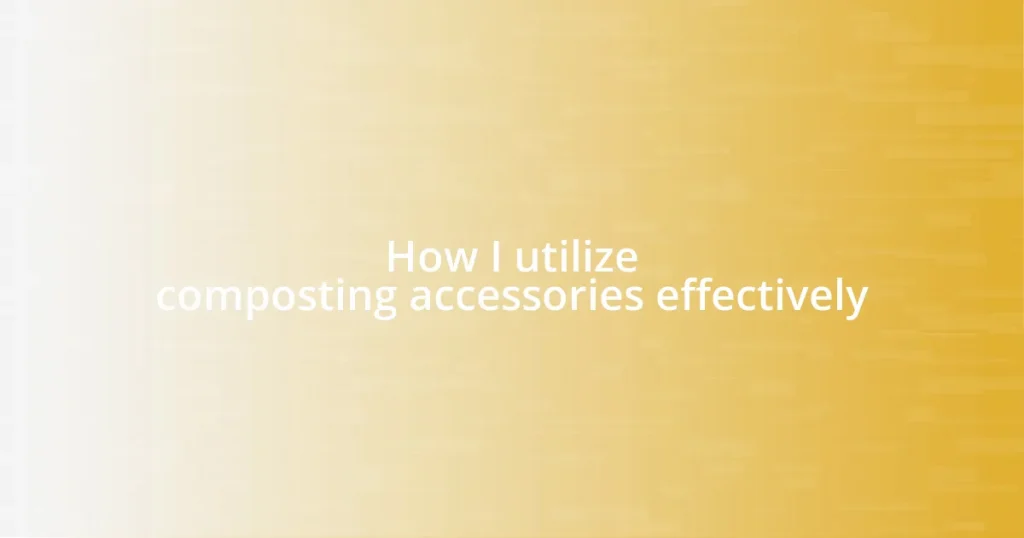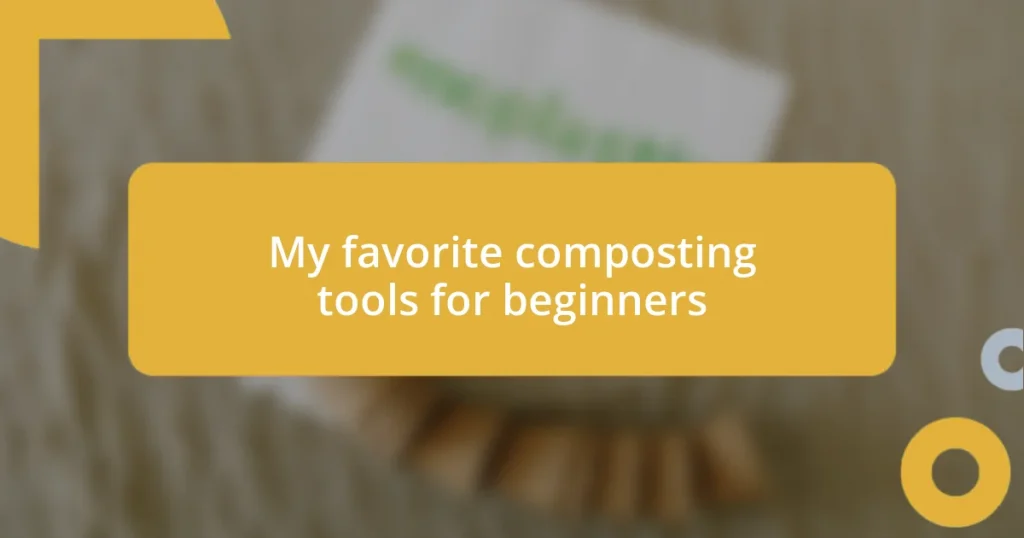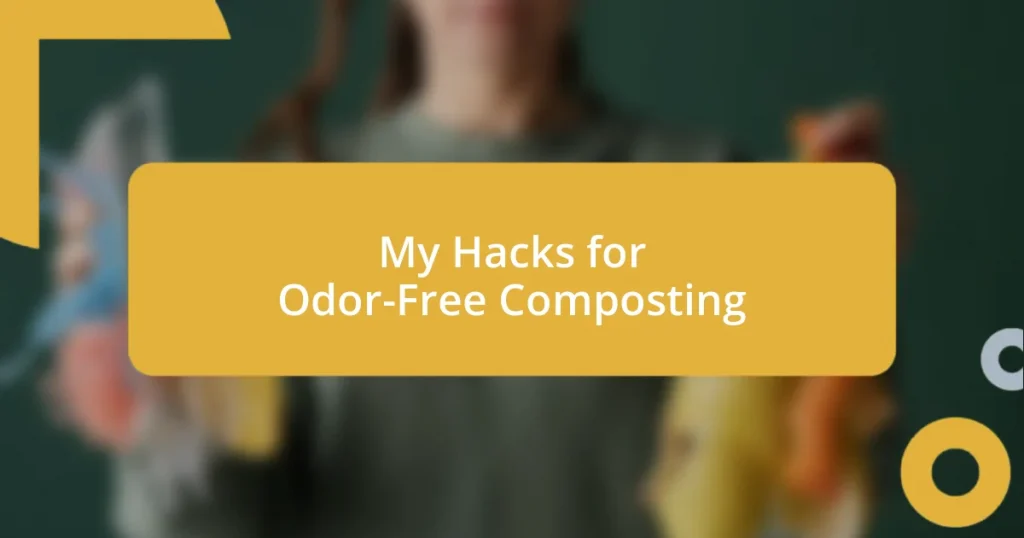Key takeaways:
- Composting kitchen scraps reduces landfill waste, enriches garden soil, and contributes to environmental sustainability by lowering methane emissions.
- Maintaining a proper balance of “greens” (nitrogen-rich materials) and “browns” (carbon-rich materials) is vital for successful composting.
- Regularly turning the compost, monitoring moisture levels, and being mindful of composting materials can prevent common issues like odors and slow decomposition.

Understanding kitchen composting
Kitchen composting is a delightful way to transform kitchen scraps into nutrient-rich soil. I still remember the first time I tossed my vegetable peels into the bin instead of the trash—I felt a sense of relief, knowing that I was reducing waste while contributing to a healthier planet. It’s fascinating how something as simple as composting can create a cycle of life right in your own kitchen.
Understanding what materials can be composted is crucial. I often find myself pondering, “Could these avocado skins really turn into compost?” The answer is a resounding yes! Composting typically allows for organic waste like fruit and vegetable scraps, coffee grounds, and even eggshells, while keeping non-biodegradables like plastic and dairy products out. This distinction makes it not only a science but also an art that can greatly impact your gardening efforts.
Moreover, the emotional satisfaction of nurturing your compost is truly rewarding. I remember the joy I felt when I first used my homemade compost in my garden, watching my plants thrive as if they were thanking me for the extra love. Does it get any better than knowing your kitchen waste has found a new purpose? It’s a beautiful reminder of how interconnected our ecosystem is and how even small actions can lead to significant benefits.

Benefits of kitchen composting
Composting kitchen scraps not only reduces the amount of waste sent to landfills but also enriches your garden soil with vital nutrients. I still recall the transformation in my garden the first time I added my compost; the vibrancy of my vegetables soared, and I felt proud knowing I was playing an active role in creating healthy soil. It’s like giving your plants a superfood boost, all derived from what would otherwise be waste.
Another fantastic aspect of kitchen composting is the environmental benefits it offers. With less waste in landfills, we significantly reduce methane emissions, a potent greenhouse gas. It’s invigorating to think that just by composting my kitchen scraps, I’m part of something bigger—a collective effort to combat climate change. Each time I toss coffee grounds or vegetable peels into my compost bin, I feel a renewed sense of purpose and connection to the planet.
Finally, composting helps you save on gardening costs. Instead of purchasing expensive fertilizers, I’ve created my own at no extra cost. I vividly remember the day I realized I no longer had to buy bagged soil conditioners; the sense of pride in using my own compost was unparalleled. It’s not just about saving money, but also about embracing a lifestyle that respects and nurtures nature.
| Benefit | Explanation |
|---|---|
| Waste Reduction | Less trash in landfills, leading to a decrease in methane emissions. |
| Nutrient-Rich Soil | Compost enhances soil health and promotes plant growth. |
| Cost Savings | Reduces the need for store-bought fertilizers and soil amendments. |

Essential composting materials
When diving into kitchen composting, the materials you choose can make all the difference. I remember the first time I saw what happens when you throw in a good mix of “greens” and “browns.” Greens include items such as fruit scraps, vegetable peels, and even coffee grounds. They provide nitrogen, which helps break down organic matter. On the flip side, browns, like dried leaves or cardboard, offer carbon – crucial for a balanced compost.
Here’s a quick overview of essential materials:
- Fruit and vegetable scraps: Citrus rinds, carrot tops, and onion skins are fantastic choices.
- Coffee grounds: Not just a morning pick-me-up; they help add nitrogen.
- Eggshells: Crushed shells contribute calcium, helping to strengthen plants.
- Dried leaves and twigs: Perfect for adding carbon and improving aeration.
- Grass clippings: Freshly mowed, they enhance nitrogen levels but should be used sparingly to avoid clumping.
I’ve felt a sense of joy when I incorporate these materials into my compost. There’s something incredibly satisfying about tossing in a blend of items and knowing they are going to transform. It’s akin to creating a flavorful stew; the right mix results in something nourishing, both for my garden and the earth. Each time I see my compost pile evolving, I can’t help but smile, reminded of the small yet profound impact we can have.

Best kitchen composting practices
One of the best practices I’ve discovered for successful kitchen composting is regularly turning the pile. The first time I dug into my compost and found a steamy, earthy aroma wafting up, I was hooked. It’s like a mini celebration of nature’s magic! Regularly turning the compost aerates it, which speeds up the decomposition process. If you’re wondering how often to turn your pile, I personally aim for every few weeks; it really keeps things lively and encourages that wonderful breakdown.
Maintaining the right moisture level is another crucial element I’ve learned through trial and error. I remember when I first started composting and was unsure how wet to keep it. After my pile dried out, it became a frustrating, crusty mess. Now, I always ensure my compost is damp but not soaking; if it feels like a wrung-out sponge, that’s just right. This balance helps the microorganisms work their magic, breaking down scraps efficiently. It’s satisfying to know that with each properly managed batch, I’m not just simplifying my waste but also nurturing a thriving ecosystem.
Lastly, being mindful of what goes into the compost can really elevate the quality of your end product. I vividly recall inadvertently tossing in some greasy pizza boxes once and then having to deal with a smelly disaster. Now, I stick to vegetable scraps, coffee grounds, and occasional paper products, steering clear of dairy and meats to prevent unwanted odors. It’s a learning curve, but one worth embracing! Have you had any similar mishaps that taught you invaluable lessons in composting? I’ve found that each mistake has made my composting journey more enriching and even more enjoyable.

Common composting mistakes
One common mistake I often see among new composters is neglecting to balance the “greens” and “browns.” In my early days, I went overboard on coffee grounds, thinking they’d accelerate everything. Instead, I ended up with a gooey mess that smelled worse than my kitchen trash! A good rule of thumb is to aim for a mix of roughly two parts browns for every one part green. Trust me, getting this balance right will save you from headaches down the road.
Another error I frequently encountered was being too impatient. I remember staring at my composter like a kid waiting for cookies to bake, expecting instant results. It wasn’t until I accepted that decomposition takes time that I found the joy in being patient. Rushing the process often leads to a malodorous outcome, so instead, embrace the waiting! Check your pile occasionally, and appreciate the small changes—it’s all part of the composting journey.
Lastly, many people mistakenly think that composting is only about scrap food. I once tossed in some colorful plastic wrappers just to clear up my counter. What a disaster! Those non-biodegradable bits not only halted the decomposition process but turned my otherwise rich compost into a landfill replica. It may seem obvious now, but it’s vital to be conscious about what you’re adding to the mix. Are you truly composting or merely recycling your serveware? This distinction will steer your efforts in the right direction!

Troubleshooting composting issues
One of the more troublesome issues I faced while composting was the presence of foul odors. I remember the shock of opening my compost bin one day to an overwhelming smell that made me regret my commitment to this eco-friendly practice. This often signals that your pile is too wet or has too many greens. Adjusting the balance by adding dry materials and ensuring proper aeration helped me regain a pleasant earthy scent rather than a stinky reminder of my mistakes.
Another hiccup I encountered was pest invasion. I can still recall the day I found tiny fruit flies buzzing around my compost bin, which was both embarrassing and frustrating. It turns out that attracting pests can be a sign of using too many soft, juicy scraps or leaving the compost uncovered. I started to secure my bin better and added a layer of browns to cover up fresh scraps, which significantly reduced those uninvited guests.
Lastly, I’m all too familiar with the struggle of slow decomposition. There was a time when I eagerly anticipated rich, dark compost only to find a half-finished pile after months of waiting. I often wondered if I had done something wrong. By learning to mix the materials better and remembering to turn it regularly, I transformed that sluggish heap into a thriving environment for microbes. Are you experiencing similar challenges? It’s all part of the learning process, and each setback is just an opportunity for growth!

Maintaining your composting bin
I can’t stress enough how essential it is to regularly check and maintain your composting bin. When I first started, I went weeks without touching mine, and when I finally did, I was greeted with a compacted lump that barely resembled compost! I learned that turning the pile every couple of weeks promotes airflow and speeds up decomposition. Plus, there’s something strangely satisfying about giving your mix a good toss. Have you felt that sense of accomplishment when you see your efforts turning into dark, crumbly goodness?
Moisture levels can also make or break your compost. Early on, I found myself fretting about whether my pile was too dry or soggy, often wondering if every drop of water was going to ruin everything. To find that balance, I started using my hand to test the pile. It should feel like a wrung-out sponge—damp, but not dripping. It’s amazing how that simple check can make such a difference. Have you ever been surprised by how small adjustments can lead to big changes in your compost?
Lastly, don’t underestimate the impact of temperature on your bin. I once made the mistake of thinking any warm spot would do. I discovered that a little heat does wonders for decomposition, as it activates those beneficial microbes. It was a lightbulb moment when I realized that insulating my bin in colder months kept things cooking steadily. Have you ever had a moment where you realized a simple tweak could elevate your success? Remember, each small detail you fine-tune adds up to a thriving composting experience!



